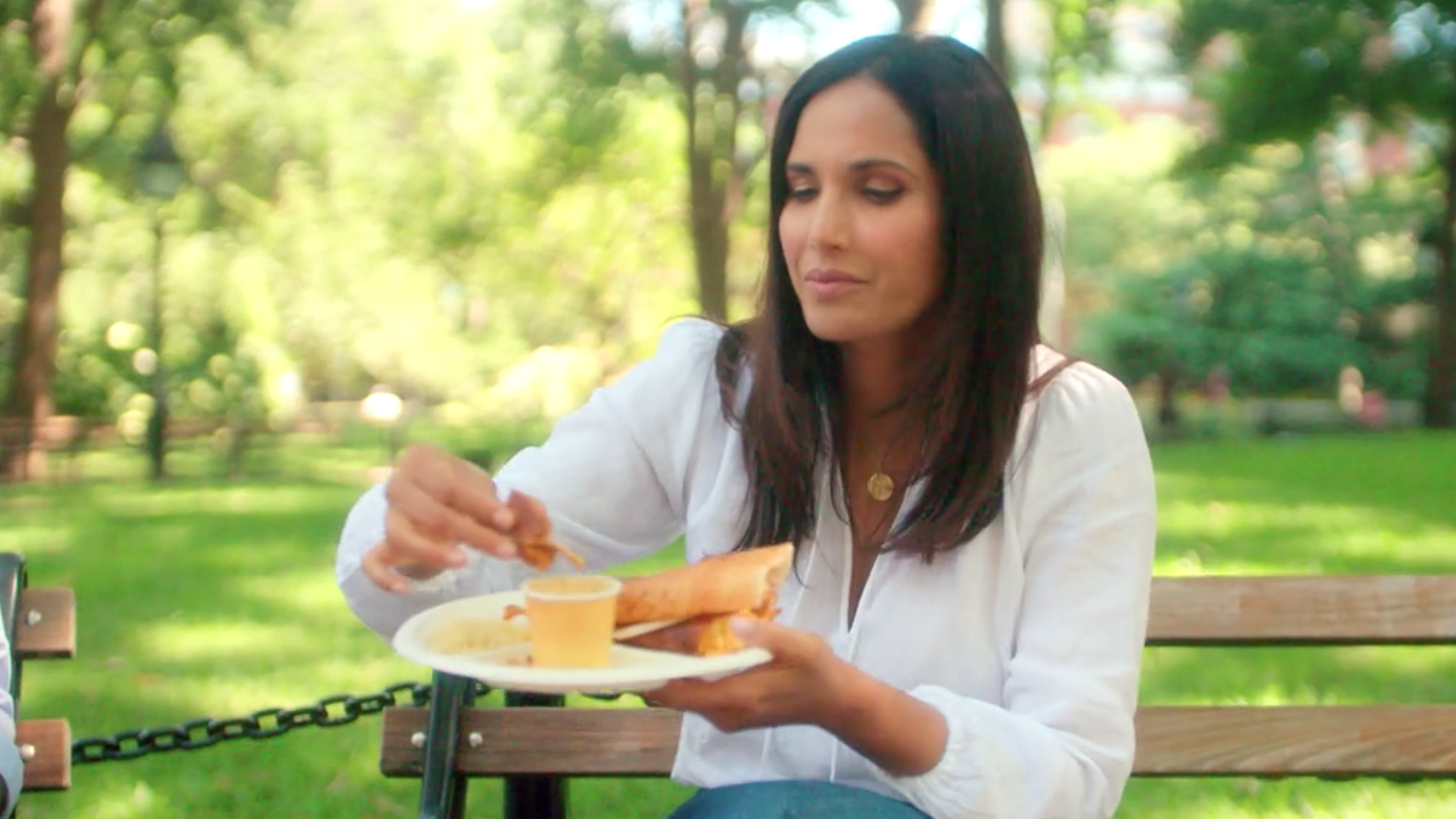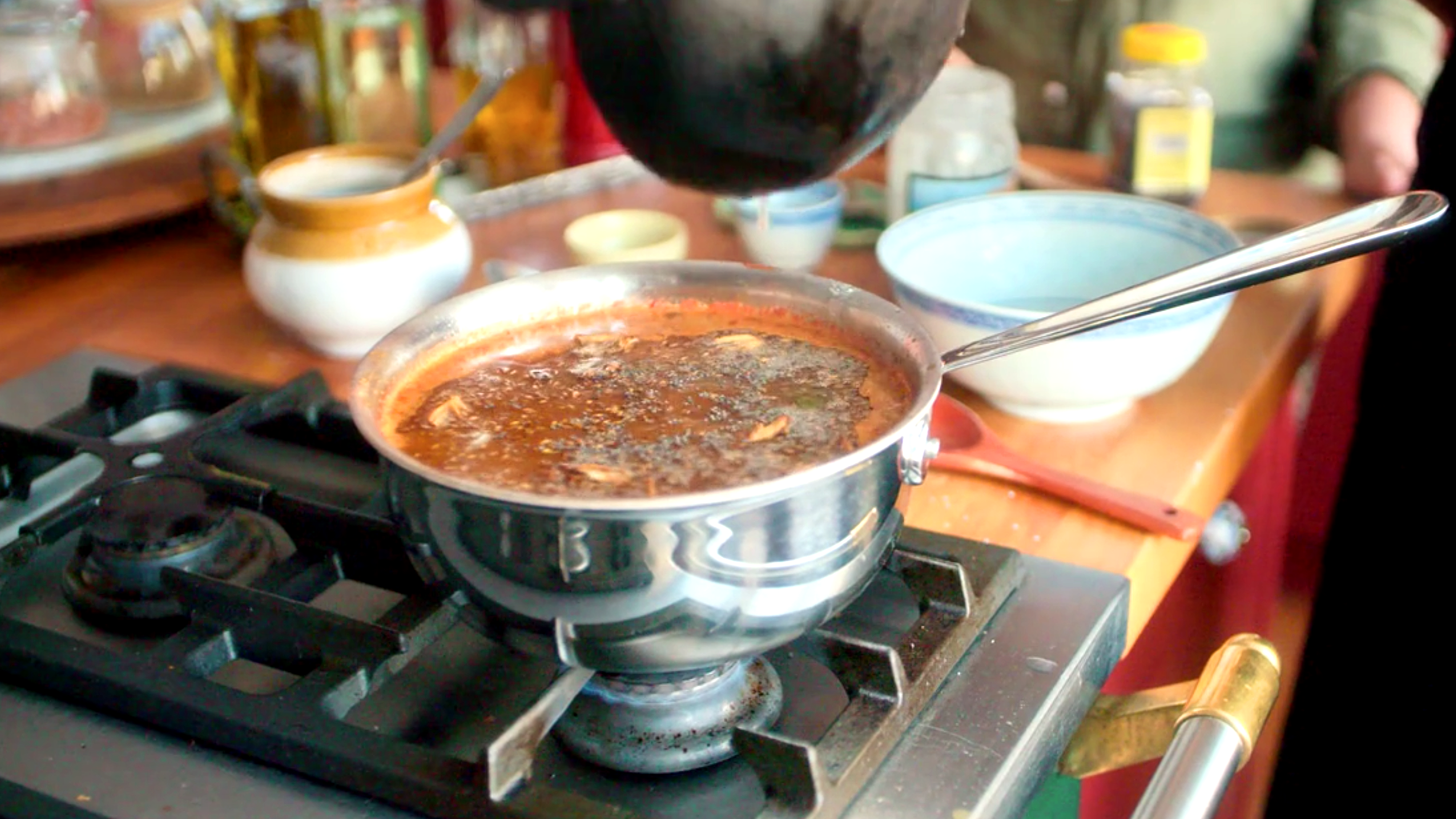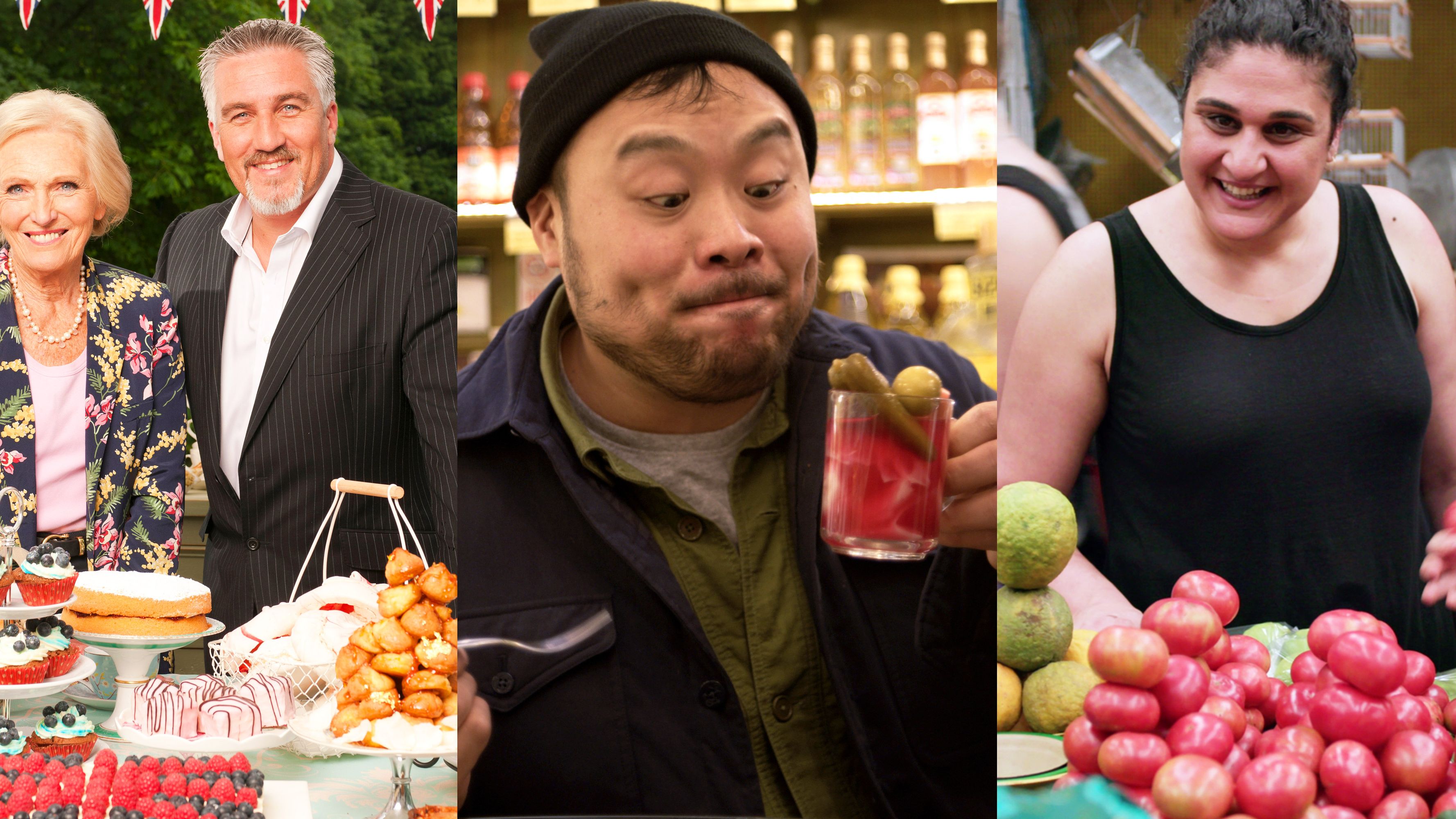Padma Lakshmi and the Art of South Indian Cooking
In 'Taste the Nation,' Lakshmi spotlights immigrants and their foods—like the rasams and dosas she and I grew up with.

"I'm eating rice and dal as we speak," Padma Lakshmi tells me. As the longtime host and executive producer of Top Chef, Lakshmi has become accustomed to divulging what she's eating. But today's recitation of her lunch seems particularly serendipitous. What follows from her admission is a lengthy chat about the food both of us, as South Indian immigrants, grew up eating: rasam (a tamarind-based soup), dosas (a thin rice pancake), yogurt rice (like savory rice pudding). It's the exact type of conversation—one about families and traditions and homes—Lakshmi hoped would be spurred by her new show, Taste the Nation.
In the 10-part Hulu series, Lakshmi travels the country shining a spotlight on the foods and immigrant communities that so-called "American" cuisine is built on. In Charleston, she explores the culture of the Gullah Geechee people, who influenced Southern dining, and in Arizona, she investigates the origins of fry bread that is steeped in the history of indigenous tribes, like the Apache; she eats Persian kabobs in Los Angeles and samples chop suey in San Francisco. And in one episode, "Don't Mind If I Dosa," she opens up her own kitchen to highlight Indian food, particularly the dishes her mother and grandmother taught her to cook and the ones she hopes to pass on to her own 10-year-old daughter, Krishna.
I chatted with Lakshmi about that particularly personal episode, learning her family's dal and sambar recipes, why she isn't partial to a masala dabba, and what she hopes Taste the Nation does for immigrant restauranteurs.
Marie Claire: One of the things I really appreciated about this episode was the showcasing of South Indian foods. I've never seen that on TV; North Indian food is much more represented. Why do you think South Indian food, like rasam and dosas, hasn't permeated the West as much as North Indian food has?
Padma Lakshmi: I think that has to do with the bulk of the immigrants from India and where they came from. That's changing now because of the tech industry, and a lot of those immigrants are actually South Indian and from other parts of India. I mean, I love Punjabi food, but I would love to see other regional Indian cuisines represented. South Indian food—obviously I'm biased—[is great]. But Gujarati food; Bengali food; Rajasthani food—they have all these stuffed peppers and things that are delicious.
MC: I've found that when I talk about Indian food, even amongst Indians, what comes up more than anything else is naan or meat-heavy dishes. A lot of people haven't heard of different regions' foods. Have you found that to be true?
PL: I think dosas freak people out if you haven't heard of it because of the fermentation. Because you have to soak the dal and the rice separately, and once it's blended you have to let it rise. And it's intimidating because you never know until hours later if it's going to come out well.
Get exclusive access to fashion and beauty trends, hot-off-the-press celebrity news, and more.
MC: What's your favorite kind of dosa?
PL: Just a plain crispy dosa with coconut chutney or tomato and onion chutney.
MC: Do you make your own dosa batter?
PL: I'll always keep a container of pre-made wet batter in my fridge because it's so easy. There's no shame in that. You're basically mixing soaked rice and lentils and salt in a blender and letting that rise and ferment. So while it's a thing that requires forethought and planning, it's not that difficult a thing to do. So having the batter in your fridge, whether you make it at home or buy it, it's the same. It gives you the freedom to make it spontaneously rather than thinking, Okay, day after tomorrow I'm going to make dosas. Life doesn't really work that way. I mean it works that way in South India because we always have dosa batter around. Because when you have a lot of kids it's easy to just make a dosa and give it to them with a cup of yogurt. It's a good thing to stave off hunger when you have nothing else in the fridge.
MC: Speaking of making food for kids: Do you have a first food memory from your childhood?
PL: We cooked a lot because there were a lot of people to feed. And we only had two burners in my grandmother's house. But we always had dosa batter. We always were boiling lentils in a pressure cooker for rasam or sambar and then making sautéed vegetable curry. That is the staple South Indian home cooked meal: plain rice, sambar or rasam, and some kind of sautéed vegetable with minimal spices and yogurt. There will be variations on that theme, but that's basically what you eat every day of the week. And then you'll have dosas in the morning or for tiffin [a light, mid-afternoon snack].
MC: People closely associate bread with Indian food, but if you're south Indian it's really rice, not bread.
PL: It's totally rice based. We ate pooris and rotis once in a while, because it was a treat. It's why I can eat a ton of rice and nothing happens to me, but if I eat bread or pasta two days in a row my tummy bloats.

Padma Lakshmi teaching her daughter how to flip dosas.
MC: Is dosa your favorite South Indian food?
PL: It's probably yogurt rice. I love yogurt rice with tempered spices like mustard seed and curry leaves and green chilies and dried chilies.
MC: As you've experienced so many more cultures and their foods, do you feel like you've gotten closer to home-style Indian cooking, or do you find yourself eating more of the foods you've discovered over the years?
PL: I find myself gravitating toward home cooking—home cooking and simple foods from all different cultures. But we eat a lot of Indian food, we always have. We usually cook one meal a day. And if it's seven days, so seven meals, four of those meals will be Indian and there will be Mexican, Italian, or Thai, or Chinese.
MC: Do you typically make sambars or rasams or do you get more ambitious?
PL: We get creative, sometimes. You asked me what is the first recipe you associate with cooking from your childhood. I'd have to say that's rasam—if I had to pick from that common everyday meal. Because it's mild. I love spicy food, but I don't put a lot of masala or curry powder or spice blend in my food. I use sambar powder, a pinch of salt, and a pinch of Kashmiri chili powder when I sauté vegetables in the "Indian style" and that's it. Or I will use the basic tadka [tempering] of Urad dal, fried in oil, with curry leaves, mustard seeds, and dried chili. That, with dal, is all I need to sauté some cabbage. I can't eat tons of garam masala in everything.
I think that's why I don't go out to eat Indian food, because it all tastes the same to me. There's the butter chicken; theres some brown gravy/red gravy/orange gravy; and then it's all just different mystery meats floating around in there. I want to see my vegetables—I think that's the biggest difference between going out to eat at an average Indian restaurant [versus] eating at home. South Indian food is much more vegetable-forward.
We make dal three or four nights a week, but the dal that we make is very mild: Just masoor dal with some spinach in it. But then we do a very simple tadka with onion, ginger, tomato, a pinch of sambar powder, and some curry leaves. We sauté that and add that to the dal that we boiled, and we blend it or just leave it. We throw in handfuls of raw spinach leaves and stir that up and turn [the heat] off. Some days we'll do sambar instead of dal. Somedays we'll do yogurt-based or coconut-based stewy dish. I use coconut milk a lot in my cooking because while we're Tamilian, we're actually from Palghat [also known as the city of Palakkad] in Kerala [on the southwestern coast]. So we incorporate pan-South Indian recipes. Because my grandmother was from Tamil Nadu—she's from Tanjore. There was always this push and pull between white sauce and red sauce because my grandfather always preferred with coconut milk and my grandmother always preferred tamarind and tomato-based.
MC: Did you learn to cook from your grandmother?
PL: My mother was a huge part [of teaching me to cook] and my grandmother and my aunts. I went from being a latchkey kid in New York City to then going home [to India] every summer for three months and living with my grandparents and my aunts. So all the women cooked together. We were always in the kitchen.
MC: Was there anything you learned from them that you wouldn't find in most recipe books?
PL: We do a sambar that has grated coconut in it. We do sambar that has both tamarind and grated coconut with fried spices in the blender, and we pour that into the sambar. That kind of sambar I've never really seen in a cookbook.
MC: I want to make a cookbook of my mom's and aunts' recipes because every family's food is unique. And worry what will happen to those recipes if I don't write them down.
PL: You should! I started doing this at the beginning of college, because I realized the same thing. Take a small, spiral notebook—somehow it's better by hand, I don't know why—and just ask them to recite the recipe. And even if you don't have the amounts, you can watch them cook it and eyeball it. And from your taste memory, you'll know what it's supposed to look like and you can recreate it. I really highly recommend you do that.

A South Indian staple, rasam.
MC: Would you ever open a South Indian restaurant?
PL: No, I would never open a restaurant of any kind. I've been approached, as you can imagine, and I've never wanted to do it. I don't have any interest in selling food. What I want to do is teach families how to feed themselves interestingly and healthily and often on a budget. My whole jam is teaching other people about foods and the communities that they come from. That's why I think context is really important in food. And that's what Taste the Nation is really about. It's about giving the microphone to the people who have not really gotten credit, or mainstream credit, thus far.
My whole jam is teaching other people about foods and the communities that they come from, and that's why I think context is really important in food.
MC: There's a part in the show when [actress] Madhur Jaffrey says she thinks our generation will create an Indian-American fusion cuisine that will help Indian food gain traction in the West. Would you be happy to see that happen—that Americanization of Indian food? Or do you hope it stays true to its roots?
PL: I think the point of cooking Indian food, instead of going out to eat, is for that authentic taste. [For instance] you can make Upma with cream of wheat, you don't have to go out and get suji [semolina]. So I think there's a way to adapt it to what's available in America. You can streamline it so it's easy to prepare in the average American kitchen without losing the authenticity of the taste. You could even make bread Upma. My family used to take old bread, when it's crumbling in the bottom of the bag, and make bread Upma. But the taste is what's important. That not everything tastes the same. That there are distinctions between different regions.
MC: Do you hope Taste the Nation encourages more immigrants to start restaurants and share their foods?
PL: I hope that watching the show makes people curious about their neighbors and more friendly toward people they may not share an ethnicity with but who live among us. The restaurant industry is taking a huge huge hit because of coronavirus, and it will be a long time before it gets back on its feet because the margins are really low in restaurants. It's not uncommon for immigrants to open food businesses because that's a skill they have to offer when you don't speak the language well or don't know the culture—what you do know is your food. And that is something you can share with other people and that is something you can make a living for your family out of. If you look at the back of any professional kitchen you will see nothing but people of color.
MC: Do you think being an immigrant changes the way you experience and perceive all foods?
PL: I think everybody is an immigrant, honestly, or a descendant of an immigrant—unless you're Navajo Nation. I think that a person's palate is decided in the first four or five years, tops. There's a lot of things I'm lax about when it comes to how I raise my child, but food is not one of them. I was very strict with how I feed her and what I feed her and in what order in her first four years of life because I knew I wanted her palette to be something that could tolerate or enjoy many different foods from many different countries. When I first came here as a child it was very difficult for me and all I would eat was rice. We would only go to restaurants that would have rice on the menu. We'd go to Mexican restaurants, and I'd have the Spanish rice. Or if we got Chinese food I could just ask for soy sauce and chili sauce and mix that into the rice and eat that, if nothing else. I didn't want my daughter to have that trouble.

Padma Lakshmi and her mom prepare rasam with tamarind and rasam powder. '
MC: On the show, you discuss wanting to change your name to distance yourself from your heritage. Did you have a similar "distancing moment" with food?
PL: I always loved Indian food, but I didn't want to take it to school. When I had people over I didn't want my mom to cook Indian food. I just wanted her to make spaghetti because I knew that every kid liked spaghetti and that was familiar to them.
MC: You also showed your spice drawer; I was surprised to see you don't have a masala dabba [container for spices].
PL: No, I don't have the round ever-silver one. I have one, but I don't use it, because the spices always get mixed up, and it's not convenient for me. I like to just pull out a drawer and have the spices arranged that way.
MC: I think you're the first Indian person I've heard of who doesn't use one.
PL: It's a beautiful artifact from our culture. But it's not convenient for me to have this round thing sitting on my counter that I have to lift the lid off of and have a spoon in there that would go from one to the other. But I'm also cooking a lot of international cuisines. I use cumin and coriander when I make other kinds of food. I use it in Mexican cooking. I use za'atar; I use sumac. So my painter's box of spices is a lot bigger than what fits into an ever-silver dabba.
MC: This has nothing to do with food, but I saw you posting about skin lightening creams and your relationship to them. Did you see that Johnson & Johnson pulled them from shelves overseas? What does that mean to you?
PL: I think those creams were terrible. It gave me a real sense of self-loathing about my skin color. It was completely unnecessary. I think they should be taken off the market. Those advertisements are so destructive. We don't need additional things holding us back as women. And beauty companies have a responsibility because we've given them billions of our dollars. And so I think they should all be abolished.
For more stories like this, including celebrity news, beauty and fashion advice, savvy political commentary, and fascinating features, sign up for the Marie Claire newsletter.
RELATED STORIES


Neha Prakash is Marie Claire's Entertainment Director, where she edits, writes, and ideates culture and current event features with a focus on elevating diverse voices and stories in film and television. She steers and books the brand's print and digital covers as well as oversees the talent and production on MC's video franchises like "How Well Do You Know Your Co-Star?" and flagship events, including the Power Play summit. Since joining the team in early 2020, she's produced entertainment packages about buzzy television shows and films, helped oversee culture SEO content, commissioned op-eds from notable writers, and penned widely-shared celebrity profiles and interviews. She also assists with social coverage around major red carpet events, having conducted celebrity interviews at the Met Gala, Oscars, and Golden Globes. Prior to Marie Claire, she held editor roles at Brides, Glamour, Mashable, and Condé Nast, where she launched the Social News Desk. Her pop culture, breaking news, and fashion coverage has appeared on Vanity Fair, GQ, Allure, Teen Vogue, and Architectural Digest. She earned a masters degree from the Columbia School of Journalism in 2012 and a Bachelor of Arts degree from The Pennsylvania State University in 2010. She lives in Manhattan with her husband and dog, Ghost; she loves matcha lattes, Bollywood movies, and has many hot takes about TV reboots. Follow her on Instagram @nehapk.